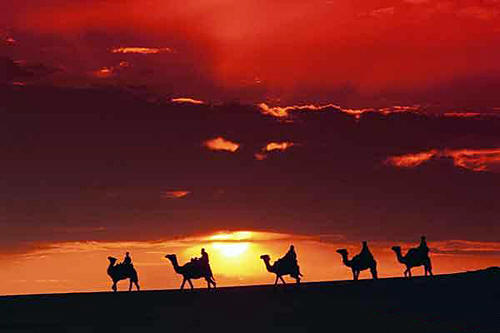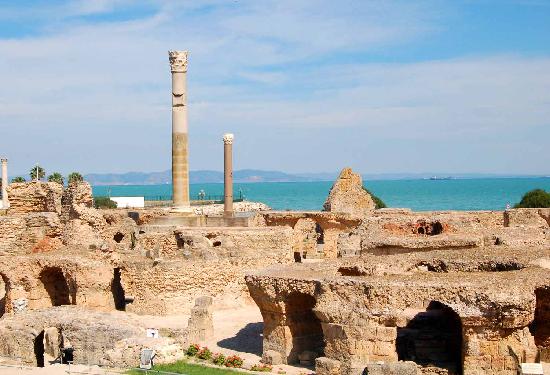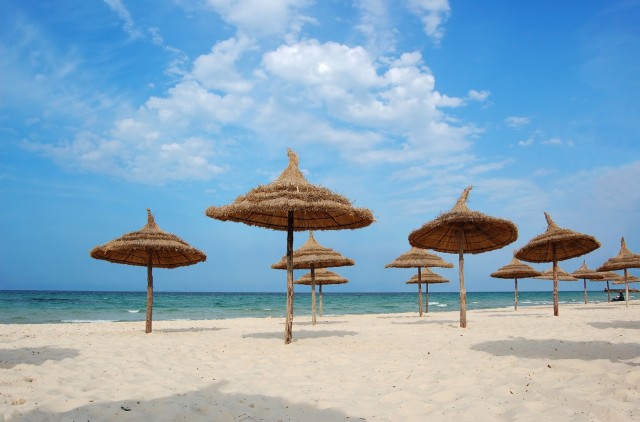
TUNISIA

Please fill in our enquiry form and a consultant will contact you. Alternatively please call our team on: |
 Just two and a half hours from London, Tunisia is a country where you will find your fill of blue sky and sunshine, extraordinary heritage and original traditions. Home to the ancient city of Carthage with thousands of years of history, the magnificent Sahara desert and beautiful Mediterranean beaches, Tunisia offers a range of activities and sights. As descendants of indigenous Berbers and a colourful mix of umpteen civilizations, modern Tunisians are a mix of ethnicities that have invaded, migrated to, and been absorbed into the population over three millennia. As a result, Tunisians are truly Mediterranean, being a "bridge" of peoples between Africa, Europe and the Levant for over 3,000 years. Recorded history commences with the arrival of Phoenicians, who founded Carthage and other North African settlements in the 8th century B.C. Over time, the Romans, Arabs, Ottoman Turks and French realised its strategic importance, claiming it as a hub for regional control and gain. As a major power, Carthage was at the heart of Mediterranean sea-trade, situated close to vital shipping routes. The Roman decline and fall in the 5th century and the capture of Carthage by Vandals in 439 prompted a Berber uprising but the Byzantines defeated both groups in 533. The Muslim conquest in the 7th century dramatically transformed Tunisia’s ethnic make-up, sparking migration from around the Arab world. Tunisia was a French protectorate from 1881 until independence in 1956 – a 75 year era that further shaped its cultural fusion. Post-liberation Tunisia was led for three decades by Habib Bourguiba. A progressive who furthered secular ideas, Bourguiba introduced some of the most advanced women’s rights in the Arab world. Reluctant to relinquish power he was eventually ousted in a 1987 bloodless coup. Zine el-Abidine Ben Ali took over the reins but stepped aside during the Arab Spring unrest of 2011. Tunisia’s first democratic elections since independence followed 10 months later, prompting large numbers to turn out to vote for Ennahda, a moderate Islamic party. Hamadi Jebali was appointed Prime Minister. Tunisia retains strong political and economic ties with the European Union. The EU accounts for over 65 per cent of Tunisian imports and more than 74 per cent of exports. Holidaymakers from Europe also represent around 80 per cent of Tunisia’s visitors each year. Tunisia’s landscape is liberally peppered with historical monuments. These pertain to diverse civilizations spanning 3,000 years, from entire ancient settlements to shrines, amphitheatres, bathing houses, churches and cenotaphs. Phoenicians, Romans, Vandals, Byzantines, Spaniards, Turks, and the French have each left an imprint on the nation’s storied terrain with well-preserved sites and intriguing age-old ruins at every turn. Growing numbers of Tunisia’s multitude of archaeological sites are now open to visitors. Seven sites have UNESCO World Heritage Site status with 46 new additions slated for UNESCO inscription – amongst them the hill-sunk Roman ruins in Oudhna which are smaller than those at El Djem, the site of the largest Roman amphitheatre in North Africa, but are nothing short of jaw-dropping nonetheless. The sites most visited are those with the easiest access, such as: Tunis Once one of the Islamic world’s greatest and wealthiest cities (12th-16th century) Tunis is easily explored on foot and has 700 monuments including madrasas, palaces, grand residential quarters, crypts, mosques and fountains that testify to its remarkable past. Covering over 250 hectares, the UNESCO-listed portion of Tunis is a fine example of an Arabo-Muslim city with its 8th century central medina, 13th century suburbs and imposing military barracks. It is also possible to visit the world’s largest collection of Roman polychrome mosaics at Tunisia’s national museum and archaeological repository, The Bardo Museum. At the height of their empire, the Romans had at least 200 cities in Tunisia as their first colony south of the Mediterranean. A legacy of this civilisation is over 26,000 listed sites – many in a remarkable state of preservation with more yet to be unearthed. People flock from all over the world to visit the city of Carthage, a great Phoenician trading empire during the 6th century given its strategic location at the mouth of the Gulf. During the lengthy Punic wars, Carthage occupied the territories that belonged to Rome, which then destroyed its rival in 146 AD. The town was rebuilt by the Romans on the ruins of the ancient city and visitors can stroll around an extensive archaeological site that dominates a hillside and the surrounding plains. Highlights include the acropolis of Byrsa, the Punic ports, the Punic tophet, the necropolises, theatre, amphitheatre, circus, residential area, basilicas and the opulent Antonine baths. Key informationTime difference +1 Hour Local currency Tunisian dinar Peak season
May - August  PORT EL KANTAOUI
PORT EL KANTAOUI
Twenty minutes from the airport, one reaches Golf El Kantaoui which is set in an exceptional site impressing visitors with a variety of flora and fauna - there are olive trees of the Roman era, eucalyptus, cactus, prestigious palm trees and a pleasant and sane environment devoid of pollution.  SOUSSE
SOUSSE
Old meets new On the east coast of Tunisia, Sousse is a place where history and culture collide. This is the country’s second biggest city, with more than 3,000 years of history to its name. The first thing you’ll notice is the medina, a UNESCO-protected site that’s home to a holy mosque and a Medieval kasbah, or fortress. Fanning out from the medina is the new town, with the port to one side and long, modern avenues to the other. They’re filled with a stream of yellow taxi cabs and locals chatting in the street. The beach Boujaafar Beach has 10 kilometres of sugar-soft sand, curling around the Gulf of Hammamet all the way up to Port El Kantaoui, a purpose-built resort just north of Sousse. The Mediterranean Sea is shallow and calm, so it’s really safe, even for paddling. Come summer, a vibrant mix of locals and visitors recline under parasols on the sand. Plus, there’s parasailing, windsurfing and jet-skis up for grabs. The main section of the beach is backed by an esplanade where you’ll find a bite to eat. The medina The 1,200-year-old medina is a riot of colour and charm. There are chaotic souks packed with leather goods and Berber rugs, and a crumbling kasbah. It also has one of the holiest mosques in the Muslim world. And if you explore the quiet backstreets, you’ll get a sneak peek of family homes hidden behind ornate Moorish doorways. Modern luxury Sousse is also a thriving North African city, with all the trappings you’d expect – sleek shopping centres, a prestigious university, and smart pavement cafés where groups of friends puff on shisha pipes. Plus, Port El Kantaoui’s smart marina and a handful of nightclubs are a 10-minute drive north.  YASMINE HAMMAMET
YASMINE HAMMAMET
A modern up-and-comer Yasmine Hammamet is an up-and-coming town along Tunisia’s beautiful northern coast. It’s a bubbly place, with a trio of boulevard, marina and sandy beach. There are elegant modern restaurants and shops dotted around. What’s more, you’ll find a trace of old Tunisia in the tea rooms and colourful markets of the quaint medina quarter. A sweep of beach The Blue Flag beach here is definitely the town’s main attraction. Golden sand slopes into sparkling waters, and there are sunloungers and umbrellas for hire. Bars and restaurants along the promenade are always bustling, too. For a near-deserted stretch of sand, the beach at Manzil Tmim is an hour away and set in an idyllic slice of Arabian countryside. Nearby Hammamet Hammamet is 20-minutes’ drive away and boasts a 13th-century old town – inside there’s the sand-coloured Great Mosque. Or you could find your way to the George Sebastian Villa, a 1920s house set in lush botanical gardens. A 5-minute drive out of Hammamet gets you to Pupput, a Roman settlement with crumbling ruins and vivid mosaics. Daytrips to Tunis and ancient Carthage Tunisia’s capital Tunis is an hour’s drive away. The 8th-century Zitouna Mosque is a highlight of the old town, while the nearby Bardo Museum is housed in a 13th-century Ottoman palace. You can see ancient relics here, or drive a few minutes to the ruined ancient city of Carthage, where a walking tour can take you round the 3,000-year old remains of the city. |

